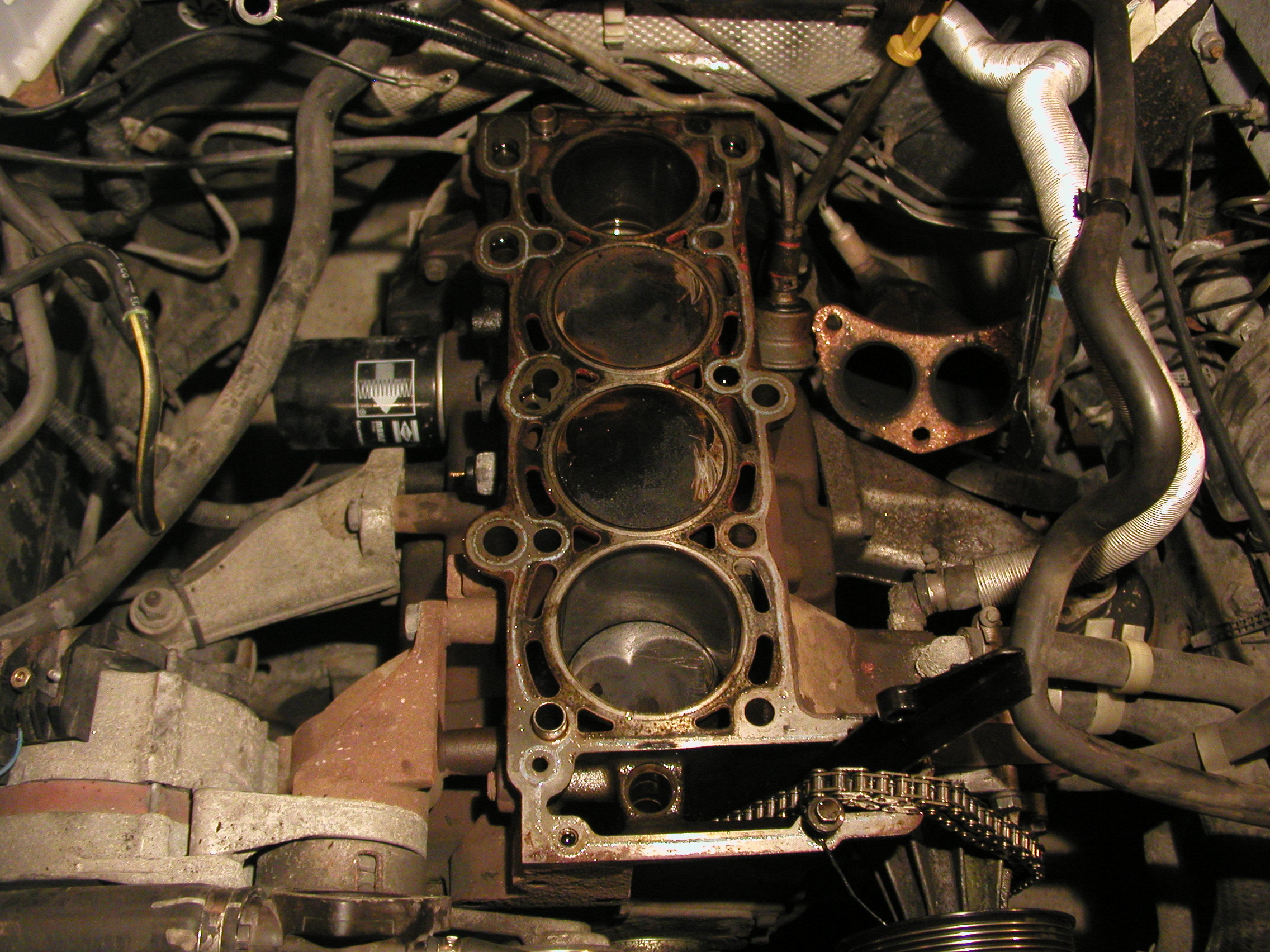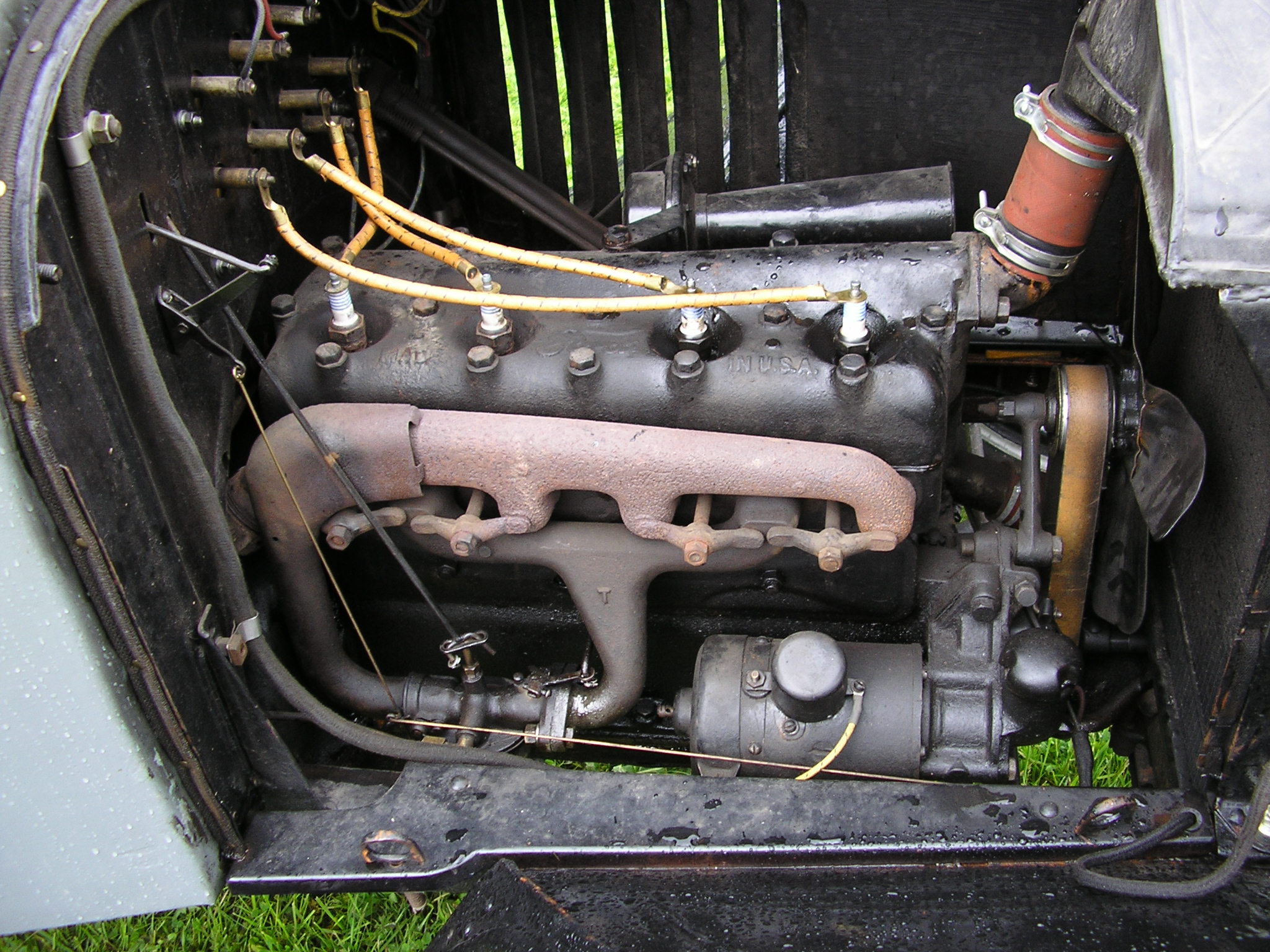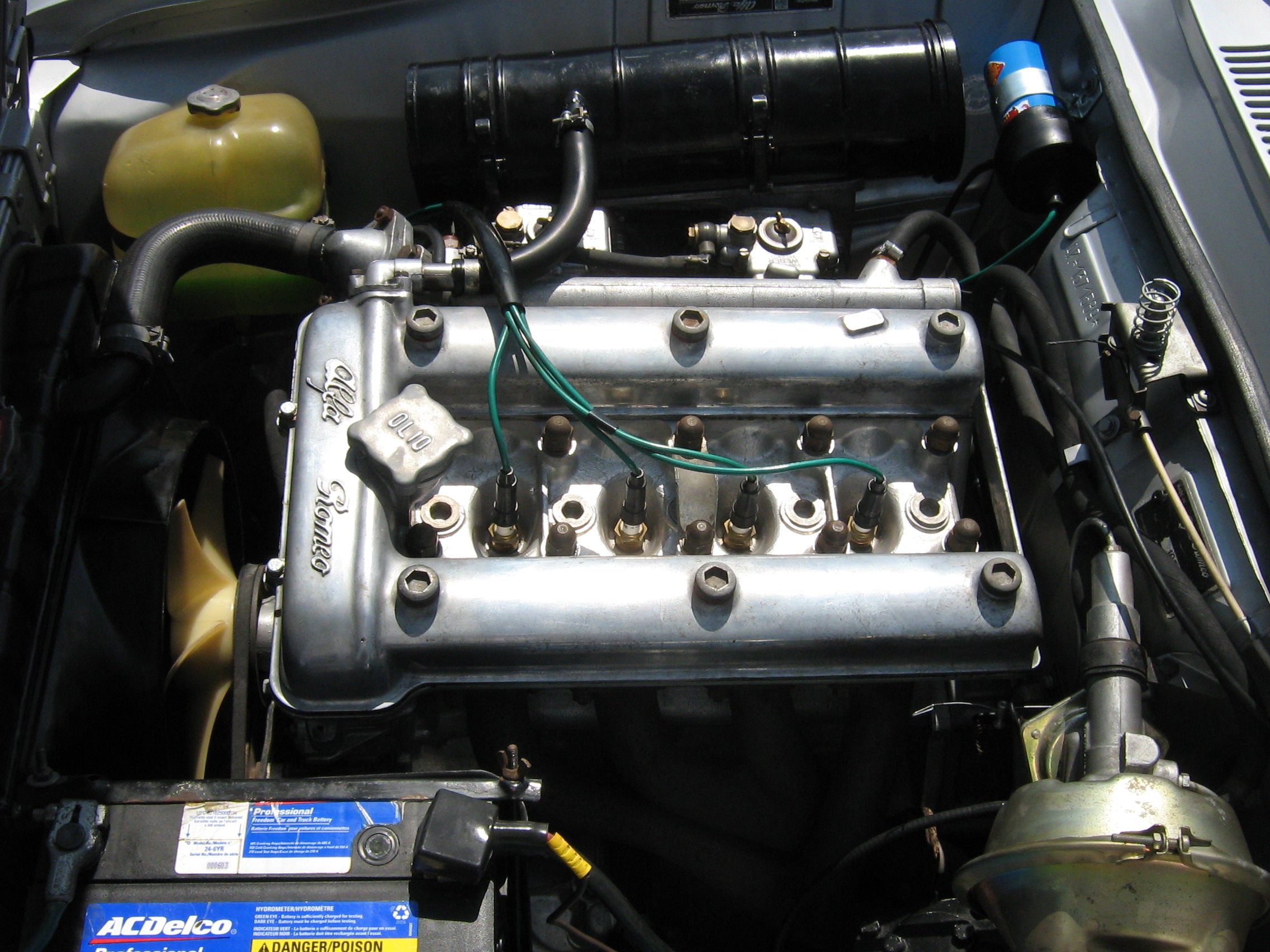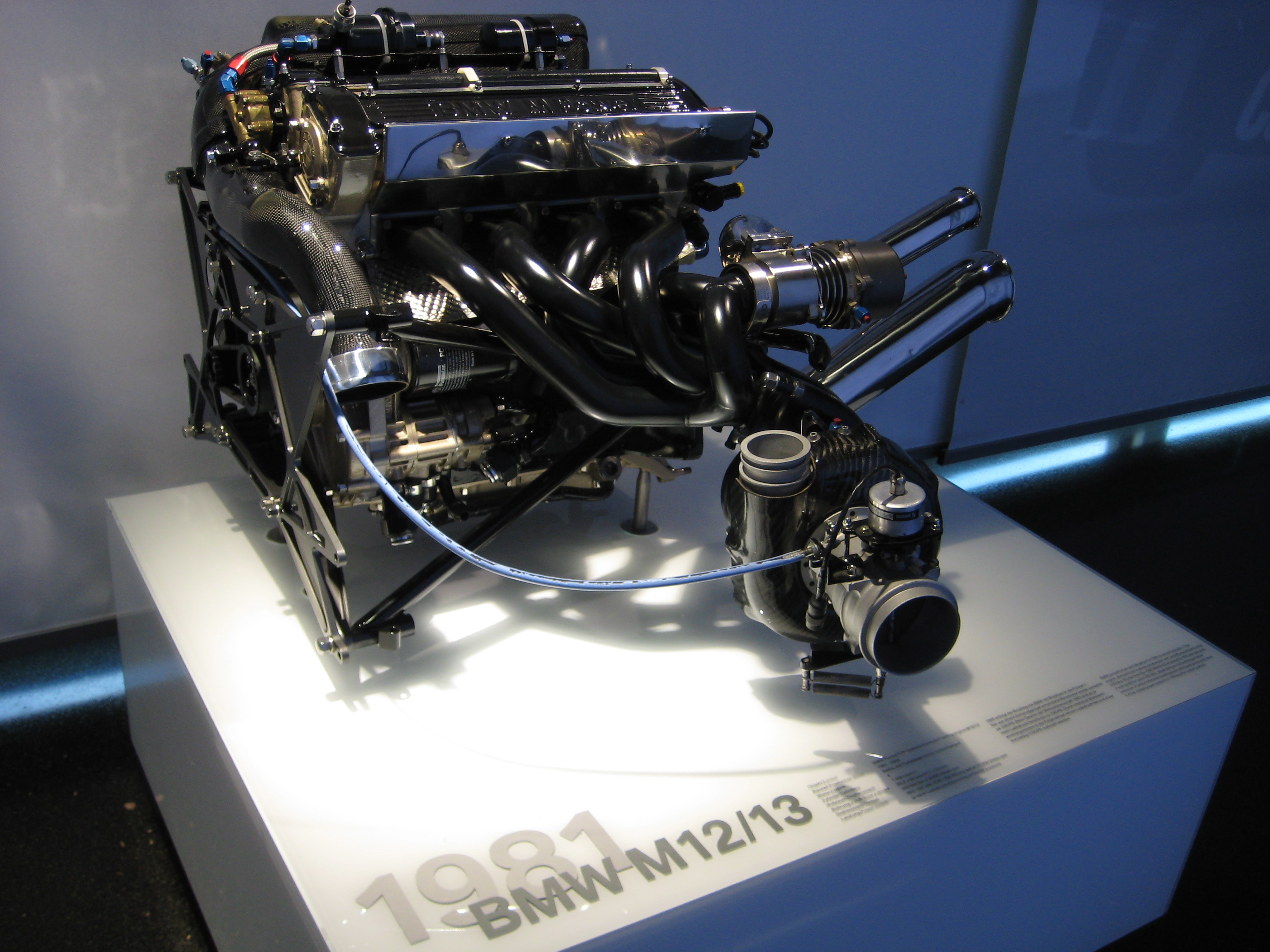Straight-four Engine on:
[Wikipedia]
[Google]
[Amazon]


 A straight-four engine (also called an inline-four) is a four-cylinder piston engine where cylinders are arranged in a line along a common crankshaft.
The vast majority of automotive four-cylinder engines use a straight-four layout (with the exceptions of the flat-four engines produced by Subaru and Porsche) and the layout is also very common in motorcycles and other machinery. Therefore the term "four-cylinder engine" is usually synonymous with straight-four engines. When a straight-four engine is installed at an inclined angle (instead of with the cylinders oriented vertically), it is sometimes called a slant-four.
Between 2005 and 2008, the proportion of new vehicles sold in the United States with four-cylinder engines rose from 30% to 47%. By the 2020 model year, the share for light-duty vehicles had risen to 59%.
A straight-four engine (also called an inline-four) is a four-cylinder piston engine where cylinders are arranged in a line along a common crankshaft.
The vast majority of automotive four-cylinder engines use a straight-four layout (with the exceptions of the flat-four engines produced by Subaru and Porsche) and the layout is also very common in motorcycles and other machinery. Therefore the term "four-cylinder engine" is usually synonymous with straight-four engines. When a straight-four engine is installed at an inclined angle (instead of with the cylinders oriented vertically), it is sometimes called a slant-four.
Between 2005 and 2008, the proportion of new vehicles sold in the United States with four-cylinder engines rose from 30% to 47%. By the 2020 model year, the share for light-duty vehicles had risen to 59%.


 Most modern straight-four engines used in cars have a displacement of . The smallest automotive straight-four engine was used in the 1963–1967
Most modern straight-four engines used in cars have a displacement of . The smallest automotive straight-four engine was used in the 1963–1967
 Many early racing cars used straight-four engines, however the Peugeot engine which won the
Many early racing cars used straight-four engines, however the Peugeot engine which won the
 Belgian arms manufacturer FN Herstal, which had been making
Belgian arms manufacturer FN Herstal, which had been making


Design
A four-stroke straight-four engine always has a cylinder on its power stroke, unlike engines with fewer cylinders where there is no power stroke occurring at certain times. Compared with aV4 engine
A V4 engine is a four-cylinder piston engine where the cylinders share a common crankshaft and are arranged in a V configuration.
The V4 engine is less common compared to straight-four engines. However, V4 engines have been used in automobiles ...
or a flat-four engine, a straight-four engine only has one cylinder head, which reduces complexity and production cost.
Displacement
Petrol straight-four engines used in modern production cars typically have a displacement of , however larger engines have been used in the past, for example the 1927-1931Bentley 4½ Litre
The Bentley 4½ Litre is a British car based on a rolling chassis built by Bentley Motors. Walter Owen Bentley replaced the Bentley 3 Litre with a more powerful car by increasing its engine displacement to . A racing variant was known as the Blo ...
.
Diesel engines have been produced in larger displacements, such as a 3.2 L turbocharged Mitsubishi engine (used the Pajero/Shogun/Montero SUV) and a 3.0 L Toyota engine. European and Asian trucks with a gross vehicle weight rating
Vehicle weight is a measurement of wheeled motor vehicles; either an actual measured weight of the vehicle under defined conditions or a gross weight rating for its weight carrying capacity.
Curb or kerb weight
Curb weight (U.S. English) or kerb ...
between 7.5 and 18 tonnes typically use inline four-cylinder diesel engines with displacements around 5 litres. Larger displacements are found in locomotive, marine and stationary engines.
Displacement can also be very small, as found in kei cars sold in Japan. Several of these engines had four cylinders at a time when regulations dictated a maximum displacement of 550 cc; the maximum size is currently at 660 cc.
Primary and secondary balance
Straight-four engines with the preferred crankshaft configuration have perfectprimary balance
Engine balance refers to how the forces (resulting from combustion or rotating/reciprocating components) are balanced within an internal combustion engine or steam engine. The most commonly used terms are ''primary balance'' and ''secondary bala ...
. This is because the pistons are moving in pairs, and one pair of pistons is always moving up at the same time as the other pair is moving down.
However, straight-four engines have a secondary imbalance. This is caused by the acceleration/deceleration of the pistons during the top half of the crankshaft rotation being greater than that of the pistons in the bottom half of the crankshaft rotation (because the connecting rods are not infinitely long). As a result, two pistons are always accelerating faster in one direction, while the other two are accelerating more slowly in the other direction, which leads to a secondary dynamic imbalance that causes an up-and-down vibration at twice crankshaft speed. This imbalance is common among all piston engines, but the effect is particularly strong on inline-four because of the two pistons always moving together.
The strength of this imbalance is determined by the reciprocating mass, the ratio of connecting rod length to stroke, and the peak piston velocity. Therefore, small displacement engines with light pistons show little effect, and racing engines use long connecting rods. However, the effect grows exponentially with engine speed (rpm).
Pulsations in power delivery

Four-stroke engine
A four-stroke (also four-cycle) engine is an internal combustion (IC) engine in which the piston completes four separate strokes while turning the crankshaft. A stroke refers to the full travel of the piston along the cylinder, in either directi ...
s with five or more cylinders are able to have at least one cylinder performing its power stroke at any given point in time. However, four-cylinder engines have gaps in the power delivery, since each cylinder completes its power stroke before the next piston starts a new power stroke. This pulsating delivery of power results in more vibrations than engines with more than four cylinders.
Usage of balance shafts
A balance shaft system is sometimes used to reduce the vibrations created by a straight-four engine, most often in engines with larger displacements. The balance shaft system was invented in 1911 and consists of two shafts carrying identical eccentric weights that rotate in opposite directions at twice the crankshaft's speed. This system was patented by Mitsubishi Motors in the 1970s and has since been used under licence by several other companies. Not all large displacement straight-four engines have used balance shafts, however. Examples of relatively large engines without balance shafts include the 2.4 litreCitroën DS
The Citroën DS () is a front mid-engined, front-wheel drive executive car manufactured and marketed by Citroën from 1955 to 1975, in fastback/sedan, wagon/estate, and convertible body configurations, across three series of one generation.
...
engine, the 2.6 litre Austin-Healey 100
The Austin-Healey 100 is a sports car that was built by Austin-Healey from 1953 until 1956.
Based on Austin A90 Atlantic mechanicals, it was developed by Donald Healey to be produced in-house by his small Healey car company in Warwick. Heal ...
engine, the 3.3 L Ford Model A (1927)
The Model A is the designation of two cars made by Ford Motor Company, one in 1903 and one beginning in 1927:
* Ford Model A (1903–1904)
* Ford Model A (1927–1931)
The Ford Model A (also colloquially called the A-Model Ford or the A, and ...
engine and the 2.5 L GM Iron Duke engine
The Iron Duke engine (also called 151, 2500, Pontiac 2.5, and Tech IV) is a Straight-4 piston engine built by the Pontiac Motor Division of General Motors from 1977 to 1993. Thereafter GM's 2.2 L OHV 4-cylinder replaced it across the ...
. Soviet/Russian GAZ Volga
The Volga (russian: Волга) is an executive car that originated in the Soviet Union to replace the GAZ Pobeda in 1956. Their role in serving the Soviet nomenklatura made them a contemporary cultural icon. Several generations of the car have b ...
and UAZ engines with displacements of up to 2.9 litres were produced without balance shafts from the 1950s to the 1990s, however these were relatively low-revving engines which reduces the need for a balance shaft system.
Usage in production cars

 Most modern straight-four engines used in cars have a displacement of . The smallest automotive straight-four engine was used in the 1963–1967
Most modern straight-four engines used in cars have a displacement of . The smallest automotive straight-four engine was used in the 1963–1967 Honda T360
The T360 is a pickup truck from Honda. Introduced in June 1963, it was Honda's first production automobile, beating the S500 Sports by four months.
The T360 used a 356 cc AK250E series DOHC inline-four engine also found in the Honda S360 ro ...
kei truck and has a displacement of , while the largest mass-produced straight-four car engine is the 1999–2019 Mitsubishi 4M41 diesel engine which was used in the Mitsubishi Pajero and has a displacement of .
Significant straight-four car engines include:
* 1954–1994 Alfa Romeo Twin Cam engine
The Alfa Romeo Twin Cam engine is an all-alloy inline-four engine series produced by Alfa Romeo from 1954 to 1994. In Italian it is known as the "bialbero" ("twin-shaft"), and has also been nicknamed the "Nord" (North) engine in reference to its be ...
: one of the first mass-produced twin-cam engines. In 1990, it became the first production engine with variable valve timing
In internal combustion engines, variable valve timing (VVT) is the process of altering the timing of a valve lift event, and is often used to improve performance, fuel economy or emissions. It is increasingly being used in combination with var ...
.
* 1908–1941 Ford Model T engine
The Ford Model T used a sidevalve, reverse-flow cylinder head inline 4-cylinder engine. It was primarily a gasoline engine. It produced for a top speed of . It was built in-unit with the Model T's novel transmission (a planetary design), s ...
: one of the most widely produced engines in the world.
* 1951–2000 BMC A-Series engine: the first engine to be used in a mass-production transverse-engined front-wheel drive car.
* 1966–2000 Fiat Twin Cam engine
Designed by ex Ferrari engineer Aurelio Lampredi, the Fiat Twin Cam (also known as the Lampredi Twin Cam) was an advanced inline-four automobile engine produced from 1966 through 2000 as a Fiat/ Lancia engine until it was replaced by the "family ...
: one of the first mass-produced twin-cam engines, produced from 1959.
* 1968–1981 Triumph Slant-4 engine
The Triumph slant-four is an inline four-cylinder petrol car engine developed by the Triumph Motor Company. It first appeared in 1968 in the Saab 99. The first Triumph model to use the engine did not appear until 1972. With an original capacit ...
: an early multi-valve
In automotive engineering a multi-valve or multivalve engine is one where each cylinder has more than two valves. A multi-valve engine has better breathing and may be able to operate at higher revolutions per minute (RPM) than a two-valve engine ...
engine which formed the basis of Saab's first turbocharged engines.
* 2000–2009 Honda F20C engine: produced the highest specific output for a naturally aspirated engine of its time.
Usage in racing cars
1913 Indianapolis 500
The Third International 500-Mile Sweepstakes Race was held at the Indianapolis Motor Speedway on Friday, May 30, 1913. Frenchman Jules Goux became the first foreign-born, and first European winner of the Indianapolis 500. His margin of victory of ...
was a highly influential engine. Designed by Ernest Henry, this engine had double overhead camshafts (DOHC) with four valves per cylinder, a layout that would become the standard until today for racing inline-four engines.
Amongst the engines inspired by the Peugeot design was the Miller engine, which was a successful racing engine through the 1920s and early 1930s. The Miller engine evolved into the Offenhauser engine which had a highly successful spanning from the 1933 until 1981, including five straight victories at the Indianapolis 500 from 1971 to 1976.
Many cars produced for the pre-WWII voiturette
A voiturette is a miniature automobile.
History
''Voiturette'' was first registered by Léon Bollée in 1895 to name his new motor tricycle. The term became so popular in the early years of the motor industry that it was used by many makers t ...
Grand Prix motor racing category used inline-four engine designs. 1.5 L supercharged engines found their way into cars such as the Maserati 4CL
The Maserati 4CL and its derived sister model the Maserati 4CLT are single-seat open-wheel Grand Prix racing cars that were designed and built by Maserati. The 4CL was introduced at the beginning of the 1939 season, as a rival to the Alfa Rome ...
and various English Racing Automobiles
English Racing Automobiles (ERA) was a British racing car manufacturer active from 1933 to 1954.
Prewar history
ERA was founded by Humphrey Cook, Raymond Mays, and Peter Berthon in November 1933 and established in Bourne, Lincolnshire, next ...
(ERA) models. These were resurrected after the war, and formed the foundation of what was later to become Formula One
Formula One (also known as Formula 1 or F1) is the highest class of international racing for open-wheel single-seater formula racing cars sanctioned by the Fédération Internationale de l'Automobile (FIA). The World Drivers' Championship, ...
, although the straight-eight supercharged Alfettas would dominate the early years of F1.
Another engine that played an important role in racing history is the straight-four Ferrari engine designed by Aurelio Lampredi
Aurelio Lampredi (16 June 1917 – 1 June 1989) was an Italian automobile and aircraft engine designer.
Born in Livorno, he began his career before World War II at Piaggio, moved to Isotta Fraschini, and then joined Reggiane. This time he des ...
. This engine was originally designed as a 2 L Formula 2
Formula Two (F2 or Formula 2) is a type of open-wheel formula racing category first codified in 1948. It was replaced in 1985 by Formula 3000, but revived by the FIA from 2009–2012 in the form of the FIA Formula Two Championship. The name re ...
engine for the Ferrari 500, but evolved to 2.5 L to compete in Formula One
Formula One (also known as Formula 1 or F1) is the highest class of international racing for open-wheel single-seater formula racing cars sanctioned by the Fédération Internationale de l'Automobile (FIA). The World Drivers' Championship, ...
in the Ferrari 625. For sports car
A sports car is a car designed with an emphasis on dynamic performance, such as handling, acceleration, top speed, the thrill of driving and racing capability. Sports cars originated in Europe in the early 1900s and are currently produced by ...
racing, capacity was increased up to 3.4 L for the Ferrari 860 Monza.
The Coventry Climax
Coventry Climax was a British forklift truck, fire pump, racing, and other specialty engine manufacturer.
History
Pre WW1
The company was started in 1903 as Lee Stroyer, but two years later, following the departure of Stroyer, it was reloca ...
straight-four engine was also a very successful racing engine, which began life as a 1.5 litre Formula 2 engine. Enlarged to 2.0 litres for Formula One in 1958, it evolved into the large 2,495 cc FPF that won the Formula One championship in Cooper's chassis in 1959 and 1960.
In Formula One, the 1980s were dominated by the 1,500 cc turbocharged cars. The BMW M12/13 engine was notable for the era for its high boost pressures and performance. The cast iron block was based on a standard road car block and powered the F1 cars of Brabham, Arrows and Benetton and won the world championship in 1983. The 1986 version of the engine was said to produce about in qualifying trim.
Usage in motorcycles
 Belgian arms manufacturer FN Herstal, which had been making
Belgian arms manufacturer FN Herstal, which had been making motorcycles
A motorcycle (motorbike, bike, or trike (if three-wheeled)) is a two or three-wheeled motor vehicle steered by a handlebar. Motorcycle design varies greatly to suit a range of different purposes: long-distance travel, commuting, cruising ...
since 1901, began producing the first motorcycles with inline-fours in 1905. The FN Four had its engine mounted upright with the crankshaft longitudinal
Longitudinal is a geometric term of location which may refer to:
* Longitude
** Line of longitude, also called a meridian
* Longitudinal engine, an internal combustion engine in which the crankshaft is oriented along the long axis of the vehicl ...
. Other manufacturers that used this layout included Pierce
Pierce may refer to:
Places Canada
* Pierce Range, a mountain range on Vancouver Island, British Columbia
United States
* Pierce, Colorado
* Pierce, Idaho
* Pierce, Illinois
* Pierce, Kentucky
* Pierce, Nebraska
* Pierce, Texas
* Pierce, We ...
, Henderson, Ace
An ace is a playing card, die or domino with a single pip. In the standard French deck, an ace has a single suit symbol (a heart, diamond, spade, or club) located in the middle of the card, sometimes large and decorated, especially in the c ...
, Cleveland
Cleveland ( ), officially the City of Cleveland, is a city in the U.S. state of Ohio and the county seat of Cuyahoga County. Located in the northeastern part of the state, it is situated along the southern shore of Lake Erie, across the U.S. ...
, and Indian
Indian or Indians may refer to:
Peoples South Asia
* Indian people, people of Indian nationality, or people who have an Indian ancestor
** Non-resident Indian, a citizen of India who has temporarily emigrated to another country
* South Asia ...
in the United States, Nimbus
Nimbus, from the Latin for "dark cloud", is an outdated term for the type of cloud now classified as the nimbostratus cloud. Nimbus also may refer to:
Arts and entertainment
* Halo (religious iconography), also known as ''Nimbus'', a ring of ligh ...
in Denmark, Windhoff in Germany, and Wilkinson in the United Kingdom.
The first across-the-frame 4-cylinder motorcycle was the 1939 racer Gilera 500 Rondine, it also had double-over-head camshafts, forced-inducting supercharger and was liquid-cooled. Modern inline-four motorcycle engines first became popular with Honda
is a Japanese public multinational conglomerate manufacturer of automobiles, motorcycles, and power equipment, headquartered in Minato, Tokyo, Japan.
Honda has been the world's largest motorcycle manufacturer since 1959, reaching a producti ...
's SOHC CB750
The Honda CB750 is an air-cooled, transverse, in-line-four-cylinder-engine motorcycle made by Honda over several generations for year models 1969–2003, plus 2007, with an upright, or standard, riding posture. It is often called the original ...
introduced in 1969, and others followed in the 1970s. Since then, the inline-four has become one of the most common engine configurations in street bikes. Outside of the cruiser category, the inline-four is the most common configuration because of its relatively high performance-to-cost ratio. All major Japanese motorcycle manufacturers offer motorcycles with inline-four engines, as do MV Agusta and BMW. BMW's earlier inline-four motorcycles were mounted horizontally along the frame, but all current four-cylinder BMW motorcycles have transverse engine
A transverse engine is an engine mounted in a vehicle so that the engine's crankshaft axis is perpendicular to the direction of travel. Many modern front-wheel drive vehicles use this engine mounting configuration. Most rear-wheel drive vehicles ...
s. The modern Triumph
The Roman triumph (Latin triumphus) was a celebration for a victorious military commander in ancient Rome. For later imitations, in life or in art, see Trionfo. Numerous later uses of the term, up to the present, are derived directly or indirectl ...
company has offered inline-four-powered motorcycles, though they were discontinued in favour of triples.
The 2009 Yamaha R1
The Yamaha YZF-R1, or simply R1, is a -class sports motorcycle made by Yamaha. It was first released in 1998, undergoing significant updates in 2000, 2002, 2004, 2006, 2007, 2009, 2015, 2018
has an inline-four engine that does not fire at even intervals of 180°. Instead, it uses a crossplane crankshaft that prevents the pistons from simultaneously reaching top dead centre. This results in better secondary balance
Engine balance refers to how the forces (resulting from combustion or rotating/reciprocating components) are balanced within an internal combustion engine or steam engine. The most commonly used terms are ''primary balance'' and ''secondary ba ...
, which is particularly beneficial in the higher rpm range, and "big-bang firing order
A big bang engine is an unconventional engine designed so that some of the power strokes occur simultaneously or in close succession. This is achieved by changing the ignition timing, changing or re-timing the camshaft, and sometimes in combinat ...
" theory says the irregular delivery of torque to the rear tire makes sliding in the corners at racing speeds easier to control.
Inline-four engines are also used in MotoGP by the Suzuki (since 2015) and Yamaha Yamaha may refer to:
* Yamaha Corporation, a Japanese company with a wide range of products and services, established in 1887. The company is the largest shareholder of Yamaha Motor Company (below).
** Yamaha Music Foundation, an organization estab ...
(since 2002) teams. In 2010, when the four-stroke Moto2 class was introduced, the engines for the class were a inline-four engine made by Honda
is a Japanese public multinational conglomerate manufacturer of automobiles, motorcycles, and power equipment, headquartered in Minato, Tokyo, Japan.
Honda has been the world's largest motorcycle manufacturer since 1959, reaching a producti ...
based on the CBR600RR with a maximum power output of . Starting in 2019
File:2019 collage v1.png, From top left, clockwise: Hong Kong protests turn to widespread riots and civil disobedience; House of Representatives votes to adopt articles of impeachment against Donald Trump; CRISPR gene editing first used to experim ...
, the engines were replaced by a Triumph
The Roman triumph (Latin triumphus) was a celebration for a victorious military commander in ancient Rome. For later imitations, in life or in art, see Trionfo. Numerous later uses of the term, up to the present, are derived directly or indirectl ...
triple engine.
See also
* Flat-four engine *V4 engine
A V4 engine is a four-cylinder piston engine where the cylinders share a common crankshaft and are arranged in a V configuration.
The V4 engine is less common compared to straight-four engines. However, V4 engines have been used in automobiles ...
References
External links
* {{DEFAULTSORT:Straight-Four Engine 4